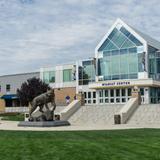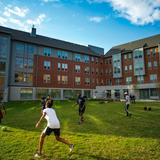- As a learning resource for education and workforce development in southeastern Massachusetts, Bristol Community College provides programs that nurture the region's economic health and wellbeing and enable individuals to make productive life choices. These programs are characterized by a strong foundation in liberal arts and sciences; an emphasis on practical, employment-oriented education in allied health, engineering and technology, and business; and workforce development from adult literacy to advanced technology skills. To serve a population rich in ethnic and linguistic diversity, and to address the education and training needs of an area who economic base is shifting from unskilled manufacturing to high-skilled service and technology industries, the College offers comprehensive developmental education and adult literacy services in a learner-centered, supportive community. The College also develops active partnerships with business and industry, public schools, colleges and universities, and social service agencies to maintain relevance and effectiveness of all credit and noncredit programming.
School Highlights
Bristol Community College serves 8,143 students (40% of students are full-time).
The college's student-teacher ratio of 13:1 is higher than the state community college average of 12:1.
Minority enrollment is 43% of the student body (majority Black and Hispanic), which is less than the state average of 57%.
Quick Facts (2025-26)
- Enrollment: 8,143 students
- In-state tuition: $4,178
- Out-state tuition: $9,122
- Student-teacher ratio: 13:1
- Minority enrollment: 43%
- Source: Integrated Postsecondary Education Data System (IPEDS)
Top Rankings
Bristol Community College ranks among the top 20% of public schools in Massachusetts for:
Category
Attribute
Community Size
Debt For Students
School Overview
The teacher population of 617 teachers has stayed relatively flat over five years.
Bristol Community College
(MA) Community College Avg.
Carnegie Classification
Associate's Colleges: High Transfer-High Traditional
Associate's Colleges: Mixed Transfer/Career & Technical-Mixed Traditional/Nontraditional
Institution Level
At least 2 but less than 4 years
At least 2 but less than 4 years
Institution Control
Public
Public
Total Faculty
617 staff
290 staff
School Calendar
Student Body
The student population of Bristol Community College has grown by 18% over five years.
The student-teacher ratio of 13:1 has increased from 10:1 over five years.
The Bristol Community College diversity score of 0.63 is less than the state average of 0.74. The school's diversity has grown by 14% over five years.
Total Enrollment
8,143 students
2,687 students
Student-Teacher Ratio
13:1
12:1
# Full-Time Students
3,278 students
1,039 students
# Part-Time Students
4,865 students
1,648 students
# Enrollment Undergraduate
814 students
278 students
# Full-Time Undergraduate Students
3,278 students
839 students
# Full-Time Graduate Students
n/a
217 students
# Part-Time Undergraduate Students
4,865 students
1,619 students
# Part-Time Graduate Students
n/a
346 students
Total Dormitory Capacity
n/a
400 students
% American Indian/Alaskan
n/a
n/a
% Asian
3%
6%
% Hispanic
12%
21%
% Black
12%
15%
% White
57%
43%
% Hawaiian
n/a
1%
% Two or more races
4%
3%
% Non Resident races
n/a
2%
% Unknown races
11%
9%
Diversity Score
0.63
0.74
College Completion Rate (Students who graduate in less than 4 years)
22%
21%
College Completion Rate (Students who graduate in 4 years or more than 4 years)
n/a
45%
Average Graduate Earnings (10 Years)
$32,000
$35,500
Tuition and Acceptance Rate
The public in-state tuition of $4,178 is less than the state average of $4,424. The in-state tuition has declined by 18% over four years.
The public out-state tuition of $9,122 is less than the state average of $9,401. The out-state tuition has declined by 9% over four years.
In-State Tuition Fees
$4,178
$4,424
Out-State Tuition Fees
$9,122
$9,401
% Students Receiving Some Financial Aid
87%
87%
Median Debt for Graduates
$6,950
$11,249
Median Debt for Dropouts
$3,300
$5,500
Acceptance Rate
n/a
75%
SAT Reading
n/a
540
SAT Math
n/a
535
SAT Writing
n/a
480
ACT Composite
n/a
21
Source: 2024 (or latest year available) Integrated Postsecondary Education Data System (IPEDS) , School Administrators
School Notes
- Bristol Community College is a public two-year, comprehensive community college offering more than 120 career and transfer programs of study that lead to associate's degrees or certificates in liberal arts, healthcare, business, engineering technology, and public safety. A learner-centered, supportive community, BCC enrolls more than 8,000 students in credit programs in four locations as well as online through the eLearning program, and hundreds more in noncredit courses and programs. Founded in 1965, BCC is the leading resource for education and workforce development in southeastern Massachusetts, continually providing programs that nurture the region's economic health and well-being and enable individuals to make productive life choices.
Frequently Asked Questions
How much does Bristol Community College cost?
Bristol Community College's tuition is approximately $4,178 for In-State students and $9,122 for Out-State students.
What is Bristol Community College's ranking?
Bristol Community College ranks among the top 20% of community college in Massachusetts for: Largest student body and Least debt for graduating students.
Recent Articles

How to Transfer from Community College to a Four-Year University in 2025
A step-by-step guide for community college students transferring to a four-year university in 2025 — updated strategies, data and expert insights.

Scholarships for Community College Students 2025
Explore updated scholarship programs, tuition data, and expert strategies for community college students in 2025.

The Rise of Technical and Vocational Training in 2025
Explore the 2025 surge in technical and vocational training—enrollment, policy, costs, and why this path is gaining ground for students and parents.











